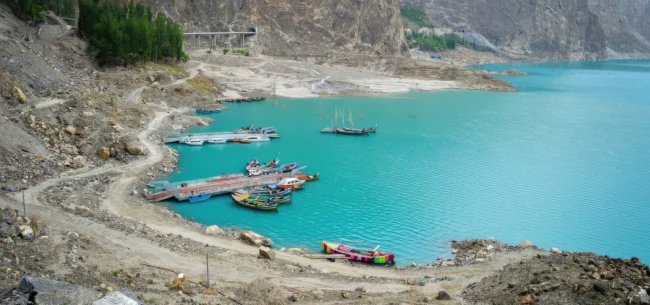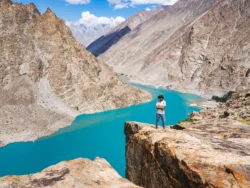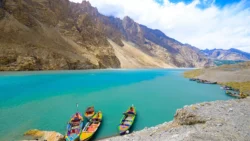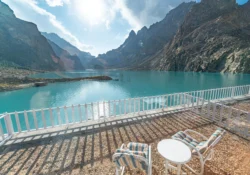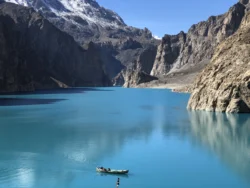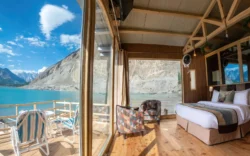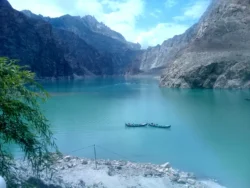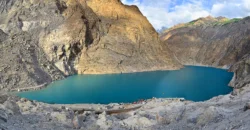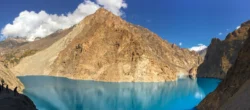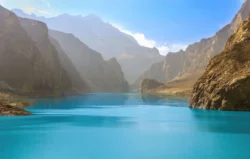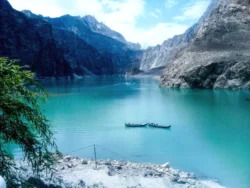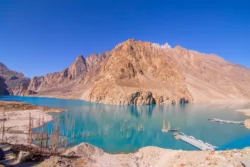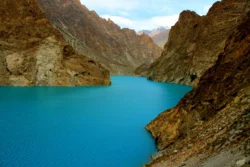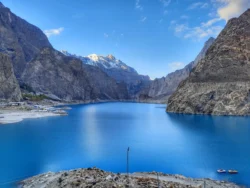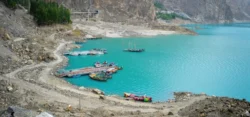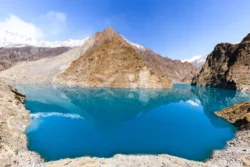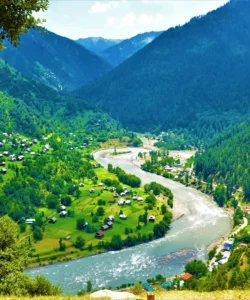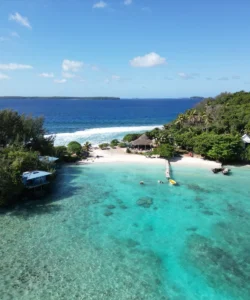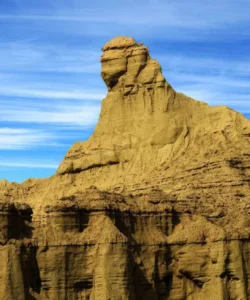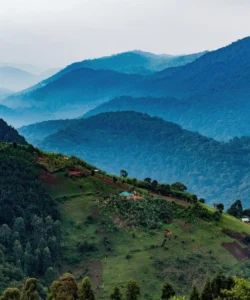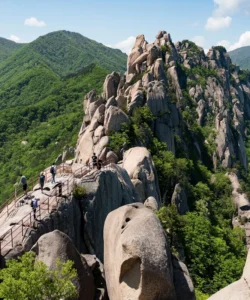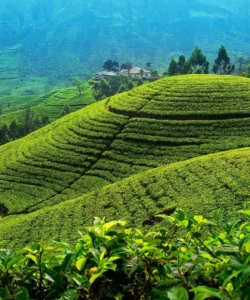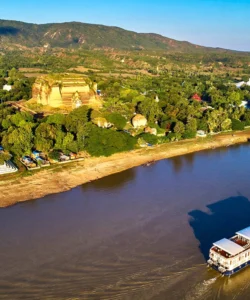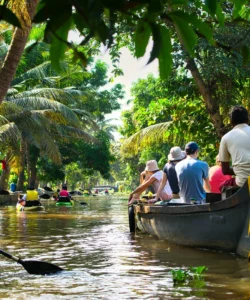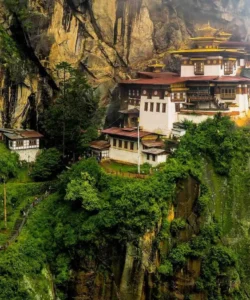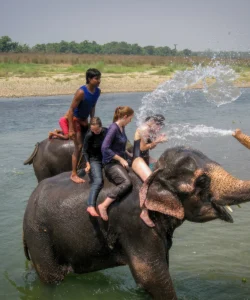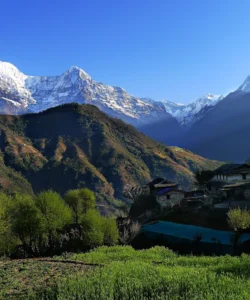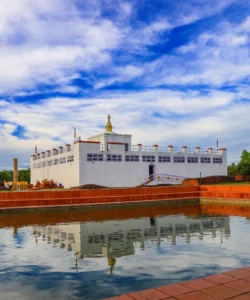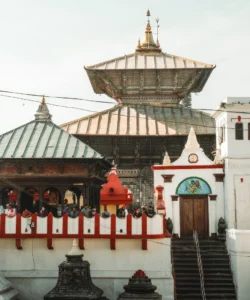Attabad Lake is a stunning natural wonder located in the Hunza Valley of Gilgit-Baltistan, Pakistan. Its mesmerizing turquoise-blue waters, set against a dramatic backdrop of towering mountains and sheer cliffs, belie its tragic and dramatic origin story. This unique lake has rapidly become one of Pakistan’s most famous and picturesque tourist destinations.
Name: Attabad Lake (Urdu: عطا آباد جھیل; also known as Gojal Lake or Attabad Lake Hunza)
Address: Gojal Region, Hunza Valley, Gilgit-Baltistan, Pakistan. It is situated approximately 14-21 kilometers upstream (east) of Karimabad, the capital of Hunza district, along the route of the Karakoram Highway.
How to Get There:
Access to Attabad Lake is primarily via the Karakoram Highway (KKH), often as part of a longer journey through the Hunza Valley.
- By Air to Gilgit (GIL): The most common way for international travelers is to fly into Gilgit Airport (GIL). Flights from Islamabad are highly weather-dependent. From Gilgit Airport, you can hire a taxi or shared van to Karimabad (approx. 2-3 hours drive along the Karakoram Highway).
- By Road via Karakoram Highway (KKH): This is the most iconic and adventurous way.
- From Islamabad/Rawalpindi: The drive along the KKH to Karimabad and then Attabad Lake is a long journey (typically 16-20 hours, often broken into two days). The KKH itself is a feat of engineering, winding through some of the world’s highest mountain ranges.
- From Gilgit: Attabad Lake is about 100-120 km north of Gilgit on the KKH.
- Through Tunnels: The lake is directly traversed by a re-aligned 24 km (15 mile) stretch of the KKH, which includes five tunnels (totaling 7 km / 4.3 miles). These “Pakistan-China Friendship Tunnels” were built to restore connectivity after the lake submerged the original highway.
- Public Transport: Long-distance buses (e.g., NATCO) operate along the KKH, connecting major cities to the Hunza Valley.
- Private Car/Jeep: Hiring a private vehicle with a driver offers flexibility and comfort.
- Within the Lake Area: Once at the lake, activities like boating, jet-skiing, and fishing are available from various points along its shores.
- Best Time to Visit:
- Summer (June-August): The most popular time. The lake’s waters are a vibrant turquoise, and the weather is generally pleasant. Ideal for water sports and enjoying the scenic beauty.
- Autumn (September-October): The surrounding trees in the Hunza Valley turn golden, creating a stunning contrast with the blue lake.
- Winter (December-January): The lake can freeze over, offering a unique opportunity for ice skating (though weather conditions need to be safe). The surrounding mountains are snow-covered, creating a different kind of serene beauty.
Landscape and Architecture:
Attabad Lake’s “architecture” is a dramatic result of geological forces and human engineering that adapted to its formation.
- Landslide-Created Lake: The lake was tragically formed on January 4, 2010, when a massive landslide occurred in Attabad village, blocking the flow of the Hunza River for five months. Over time, the impounded water created this long, deep lake. It is approximately 21 kilometers (13 miles) long and over 100 meters (330 ft) deep.
- Striking Turquoise-Blue Water: The lake is famous for its incredibly vivid turquoise-blue color. This unique hue is attributed to glacial minerals suspended in the water, which interact with sunlight, especially during the summer melt season. The clarity of the water is exceptional, often showing reflections of the sky and mountains.
- Sheer Cliffs and Submerged Valleys: The lake is nestled amidst the majestic and rugged peaks of the Karakoram mountain range. The steep, often sheer cliffs of the surrounding mountains plunge directly into the deep lake. The submerged sections of the original Hunza Valley, including parts of villages and agricultural land, lie beneath its surface.
- “Pakistan-China Friendship Tunnels”: A significant man-made architectural element directly associated with the lake are the five tunnels (totaling 7 km / 4.3 miles) along the re-aligned Karakoram Highway that hug the lake’s edge. These tunnels, completed in 2015, are a testament to engineering resilience, ensuring connectivity through the region after the original KKH was submerged by the lake.
- No Natural Outflow: The lake is essentially a natural dam created by the landslide debris, with the Hunza River now flowing over the landslide area, creating a cascade.
- Developing Tourist Infrastructure: Along its shores, especially near the tunnels and popular viewing points, a nascent tourism infrastructure has developed, including small hotels, resorts, and activity centers, often built with modern designs to accommodate the influx of visitors.
What Makes It Famous:
- Dramatic Origin Story: Attabad Lake is famous for its unique and tragic formation as a result of a massive landslide that blocked a major river. This powerful display of nature’s destructive and creative forces makes its existence inherently dramatic.
- Stunning Turquoise Water: Its incredibly vivid and striking turquoise-blue waters, contrasting sharply with the rugged mountain backdrop, are its most visually appealing and famous feature, making it a highly sought-after photographic destination.
- Symbol of Resilience: The lake has become a powerful symbol of resilience for the local communities who adapted to its creation, and for Pakistan, showcasing how a disaster can transform into a beautiful natural attraction and a source of economic opportunity through tourism.
- Water Sports and Activities: It’s a popular hub for various water-based activities that were previously unavailable in the region, including boating, jet-skiing, and fishing. In winter, it can even offer ice skating when frozen.
- Part of the Hunza Valley Experience: It’s a central highlight of any trip to the spectacular Hunza Valley, complementing the ancient forts, terraced orchards, and soaring peaks.
- Karakoram Highway Re-alignment: The engineering feat of re-aligning the Karakoram Highway with tunnels along the lake’s edge is a significant achievement linked to its fame.
- Winter Beauty: Its transformation into a frozen lake in winter, surrounded by snow-covered mountains, offers a completely different and equally captivating visual experience.
Differences from Some Other Wonders:
- Origin as a Landslide Dam Lake: Unlike naturally formed tectonic lakes (like Lake Toba), glacial lakes (like Saif-ul-Muluk), or volcanic lakes (like Kelimutu, Lonar), Attabad Lake’s defining characteristic is its creation by a relatively recent, massive landslide that impounded a river. This specific and dramatic geological origin sets it apart.
- “Brand New” Natural Wonder: Having formed in 2010, Attabad Lake is a remarkably “young” natural wonder, constantly evolving and rapidly becoming famous in the 21st century, contrasting with ancient historical sites or long-established natural landmarks.
- Integration with Modern Highway Tunnels: Its direct intersection with the re-aligned Karakoram Highway, featuring significant tunnels built specifically to bypass the lake, creates a unique blend of natural disaster, engineering ingenuity, and modern infrastructure that is not typically found in other natural lakes.
- Focus on Water Sports in a Mountainous Region: While other mountain lakes offer scenic beauty, Attabad Lake has rapidly become known for its active water sports scene (jet-skiing, power boating), which is a less common feature for lakes nestled so deeply within high-altitude mountain ranges.
- Dramatic Visual Contrast: The almost impossibly bright turquoise water against the backdrop of barren, sheer mountain cliffs (which were the source of the landslide) creates a visually striking and unique aesthetic.
- Symbol of Adaptation: The lake serves as a living testament to human and natural adaptation to a catastrophic event, offering a powerful narrative of resilience and transformation.
Attabad Lake Photos:
